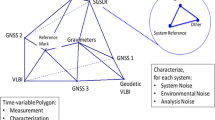Abstract
In this study, an environmental simulation platform (ETS-02) was constructed for high-precision geodesic instruments (e.g., absolute/relative gravimeters and inclinometers), to test the disturbances caused by environmental fluctuations. The outer layer of the platform was constructed with two sets of rectangular electromagnetic coils, which generated the required magnetic field when current was applied. The inner layer was a closed cabin in which radiators were distributed such that the temperature of the experimental space inside the cabin could be controlled, by energy exchange between the radiators and a thermal controller through the flowing liquid. A high-precision hexapod was used to simulate the tilt-related effect. The platform was capable of adjusting temperatures within a dynamic range of 0°C–70°C at a resolution of 0.01°C. The noise of the power-spectrum density when the cabin was set to room temperature was measured as 0.03°C/Hz1/2 at 1 mHz. The magnetic field simulation had a dynamic range of ±300 μT and stability of 20 nT. The resolution of the ground-tilt simulation was 1 arc s. The inner space of the platform had a volume of approximately 5 m3, which is sufficient for most types of instruments to be tested for a general environmental coupling effect. To illustrate the application of the platform, a dual-axis inclinometer was built and tested carefully with the platform, and the accuracy of the calibration factors was found to be significantly improved.
Similar content being viewed by others
References
Carbone, L., Cavalleri, A., Ciani, G., et al., 2007, Thermal gradient-induced forces on geodesic reference mass for LISA: Physical Review D, 76(10), 102003.
Fisher, C. J., 2010, Using an accelerometer for inclination sensing: Analog devices application note AN-1057, http://www.analog.com.
Fores, B., Champollion, C., Moigne, N., et al., 2017, Impact of ambient temperature on spring-based relative gravimeter measurements: Journal of Geodesy, 91(3), 269–277.
Gao, J. Z., 2004, Detection of weak signals: Tinghua University Press, Beijing, 156–170.
Hu, B., 2014, Magnetic field simulation and control technology in a magnetic field shield space: MSc Thesis, Nanjing University of Technology.
Metzger, E. H., 1982, Development experience of gravity gradiometer system: IEEE PLANS 82, Atlantic City, NJ, USA, 323–332.
Li, L. Y., Sun, Z. Y., Pan, D. H., et al., 2015, Status reviews for nearly zero magnetic field environmental facility: Transactions of China Electrotechnical Society, 30(15), 136–140.
Li, Y. G., 2011, Study of test and compensation technique of high precison accelerometer: MSc Thesis, Harbin Institute of Technology.
Liang, H. W., Tao, M., and Meng, Q. H., 2005, Design and implementation of a digital inclinometer: Procedings of the IEEE international conference on mechatronics and automation, 1(1), 489–492.
Liu, H., Zou, J., Li, G., et al., 2010, Research on methods of improving accuracy of tilt sensor: Piezoelectrics & Acoustooptics (in Chinese), 32(2), 207–209.
Liu, W. B., Cao, G. Z., Li, Y. G., et al., 2013, The present situation and development of temperature and humidity environment test facility: Modern Manufacturing Engineering, 2013(11), 133–140.
Lobo, A., Nofrarias, M., and Sanjuan, J., 2005, Thermal diagnostics for LTP: Classical and Quantum Gravity, 22(10), S171–S176.
Luo, J., Chen, L. S., Duan, H. Z., et al., 2016, TianQin: a space-borne gravitational wave detector: Classical and Quantum Gravity, 33(3).
Peterson, J., 1993, Observations and modeling of seismic background noise: U.S. Geol. Survey Open-File Report, Albuquerque, New Mexico.
Tu, H. B., Bai, Y. Z., Zhou, Z. B., et al., 2009, Measurement of magnetic properties of an inertial sensor with a torsion balance: CHIN. PHYS. LETT., 26(4), 39–42.
Tu, H. B., He J. G., Liu, L. J., et al., 2015, Performance characteristics for the g-sensitive elastic structure of CHZ-II sea gravimeter: Journal of Geodesy and Geodynamics, 35(4), 711–714.
Author information
Authors and Affiliations
Corresponding author
Additional information
This work was supported by National Scientific Instrument Development Fund (No. ZDYZ2012-1-04) and State Natural Sciences Fund (No. 11235004, 91636112, 41474163).
Hai-Bo Tu, doctor, associate professor, with research interests lying in precision measurement physics and geodesy, now mainly works in high-precision inertial sensor design, weak force noise modeling and characteristics. Contact details: Innovation Academy for Precision Measurement Science and Technology, CAS, Xudong Street 340, Wuhan 430077, China
Rights and permissions
About this article
Cite this article
Tu, HB., Sun, H., Liu, K. et al. Environmental simulation platform and its application to geodesic instruments for a performance study. Appl. Geophys. 17, 756–763 (2020). https://doi.org/10.1007/s11770-020-0859-x
Received:
Revised:
Published:
Issue Date:
DOI: https://doi.org/10.1007/s11770-020-0859-x




